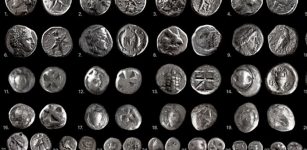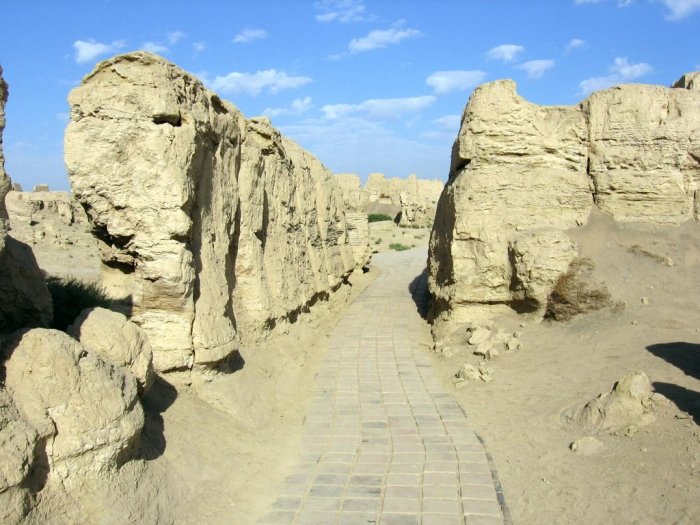Ruins Of 2,300-Year-Old City Of Jiaohe On The Silk Road
A. Sutherland - AncientPages.com - Jiaohe (in Chinese: 'where two rivers meet') is considered one of China's oldest, largest, and best-preserved earthen cities.
It was built 2,300 years ago, and its ruins are located along the Silk Road in the Yaernaizi Valley, 10 kilometers (6.2 miles) west of Turpan in Xinjiang Uygur Autonomous Region, China.
 Ruins of Jiaohe, a city where all the buildings were dug from earth and wood was rarely used. Credits: China Tour Guide
Ruins of Jiaohe, a city where all the buildings were dug from earth and wood was rarely used. Credits: China Tour Guide
As wood was rarely used, all its buildings were constructed from the earth. People dug houses and rooms downward from the ground and built them with dried bricks.
Jiaohe's main street was long and went down to the center of the islet (1650 m in length, 300 m wide), dividing the city into two parts. The western part was for ordinary people, and the rulers lived in the east. In the northwestern part of the city is a Buddhist monastery, and around China's oldest Buddhist stupa, there are 25 smaller stupas built in all directions.
 Buddhist stupa at Jiaohe Ruins. Photo: commons.Wikimedia
Buddhist stupa at Jiaohe Ruins. Photo: commons.Wikimedia
Jiaohe, which covered 220,000 square meters (2,368,168 square feet), was not like many other ancient cities.
First, it had only two city gates; the South Gate was the main one and vanished long ago, and the East Gate was cut from the side of the cliff, and a few remnants are still recognizable today.
No house gates faced the streets; military defense was seemingly the highest priority for this desert military town with a stronghold from 1,600 years ago.
Turfán (Turpan/Tulufán) es una ciudad-oasis en la Región Autónoma Uigur de Xinjiang en la República Popular China. Ruinas de la antigua ciudad de Jiaohe. Image credit: Colegota - CC BY-SA 2.5 ES
According to Tang dynasty records, Jiaohe had a population of 7,000. Second, typical city walls that usually surround other ancient cities were never found in the town; instead, Jiaohe faced cliffs on three sides.
Both excavations and historical records reveal evidence that Jiaohe (or 'Yarkhoto') was a flourishing ancient trading center and Jiaohe's military importance.
Sir Marc Aurel Stein (1862 - 1943) was a British archeologist and explorer of the Silk Road who traversed 25,000 miles of central Asia and western China. He suggested that the name 'Yarkhoto' is a combination of Turkic and Mongolian words.
The ancient city of Yar?ol near Turpan in the Xinjiang Uyghur Autonomous Region of the People’s Republic of China Image credit: Gregor Kneussel - CC BY-SA 3.0
With a history of more than 2,000 years, Jiaohe Ancient City stands isolated on a 30-meter-high plateau in the Ya'ernaizi Valley, 10 kilometers east of Turpan. The whole city of Jiaohe Ancient City stretches about 1650 meters from south to north and 300 meters from east to west.
The relics, still identifiable in this unique city, originated from Tang Dynasty (618-907) architectural style. According to Tang Dynasty historical records, Jiaohe was the capital of the Jushi Kingdom in 108 BC and remained until 450 AD.
Archaeological excavations revealed traces of the Jushi Kingdom at Jiaohe Valley, shedding more light on the early period of the region.
Later, Jiaohe continued to be an essential site for the Silk Road until it lost importance and was eventually destroyed by Genghis Khan.
Written by – A. Sutherland AncientPages.com Staff Writer
Updated on April 25, 2023
Copyright © AncientPages.com All rights reserved. This material may not be published, broadcast, rewritten or redistributed in whole or part without the express written permission of AncientPages.com
Expand for referencesMore From Ancient Pages
-
 DNA Evidence Ice Age Humans Migrated From China To The Americas And Japan
DNA | May 9, 2023
DNA Evidence Ice Age Humans Migrated From China To The Americas And Japan
DNA | May 9, 2023 -
 Mystery Of The Minoan Blue Monkeys Depicted In Frescoes
Archaeology | Apr 16, 2020
Mystery Of The Minoan Blue Monkeys Depicted In Frescoes
Archaeology | Apr 16, 2020 -
 Strange Mist, Unexplained Vanishings And Other Bizarre Incidents – What Is The Connection?
Featured Stories | Mar 8, 2019
Strange Mist, Unexplained Vanishings And Other Bizarre Incidents – What Is The Connection?
Featured Stories | Mar 8, 2019 -
 Why Is A ‘Piggy Bank’ Shaped Like A Pig?
Ancient History Facts | Jun 11, 2018
Why Is A ‘Piggy Bank’ Shaped Like A Pig?
Ancient History Facts | Jun 11, 2018 -
 Sacred Hidden Buyan Island And The Mysterious Alatyr Stone With Healing Powers May Have Existed
Featured Stories | Mar 22, 2018
Sacred Hidden Buyan Island And The Mysterious Alatyr Stone With Healing Powers May Have Existed
Featured Stories | Mar 22, 2018 -
 Gods’ Creation Of Five Different Human Races – Ages Of Man On The Earth And The End Of The World
Featured Stories | Jan 26, 2018
Gods’ Creation Of Five Different Human Races – Ages Of Man On The Earth And The End Of The World
Featured Stories | Jan 26, 2018 -
 525-Million-Year-Old Fossil Defies Textbook Explanation For Brain Evolution
Archaeology | Nov 25, 2022
525-Million-Year-Old Fossil Defies Textbook Explanation For Brain Evolution
Archaeology | Nov 25, 2022 -
 Mysterious People Who Appeared Out Of Nowhere
Featured Stories | Sep 1, 2018
Mysterious People Who Appeared Out Of Nowhere
Featured Stories | Sep 1, 2018 -
 Controversial Atacama Skeleton Is Not An Alien – DNA Study Reveals
Archaeology | Mar 23, 2018
Controversial Atacama Skeleton Is Not An Alien – DNA Study Reveals
Archaeology | Mar 23, 2018 -
 Who Were The Blue People Of Kentucky?
Featured Stories | Apr 5, 2022
Who Were The Blue People Of Kentucky?
Featured Stories | Apr 5, 2022 -
 Incredible Treasure Of Extremely Rare Greek Coins And Aqueduct Found In Ancient Tenea, Greece
Archaeology | Jan 10, 2024
Incredible Treasure Of Extremely Rare Greek Coins And Aqueduct Found In Ancient Tenea, Greece
Archaeology | Jan 10, 2024 -
 First Carbon-Based Paleolithic Paintings Found In Font-De-Gaume Cave, France Could Be 19,000 Years Old
Archaeology | Dec 29, 2023
First Carbon-Based Paleolithic Paintings Found In Font-De-Gaume Cave, France Could Be 19,000 Years Old
Archaeology | Dec 29, 2023 -
 Afterlife Of Egyptian Religious Statues Intentionally Hidden In The Temple Of Ptah At Karnak
Archaeology | Sep 22, 2017
Afterlife Of Egyptian Religious Statues Intentionally Hidden In The Temple Of Ptah At Karnak
Archaeology | Sep 22, 2017 -
 Vikings’ Encounters With Peculiar White-Dressed Humanoids And Cave Dwellers In Unknown Lands Described In Norse Sagas
Featured Stories | Sep 5, 2024
Vikings’ Encounters With Peculiar White-Dressed Humanoids And Cave Dwellers In Unknown Lands Described In Norse Sagas
Featured Stories | Sep 5, 2024 -
 On This Day In History: Favorite Ship Of King Henry VIII ‘Mary Rose’ Sank – On July 19, 1545
News | Jul 19, 2016
On This Day In History: Favorite Ship Of King Henry VIII ‘Mary Rose’ Sank – On July 19, 1545
News | Jul 19, 2016 -
 Cosmic Impact Destroyed Huge Ancient City In The Jordan Valley – Evidence Has Been Found!
Archaeology | Sep 22, 2021
Cosmic Impact Destroyed Huge Ancient City In The Jordan Valley – Evidence Has Been Found!
Archaeology | Sep 22, 2021 -
 What Is The Avoidance Custom Of The Amish People In Pennsylvania?
Ancient History Facts | Jul 29, 2019
What Is The Avoidance Custom Of The Amish People In Pennsylvania?
Ancient History Facts | Jul 29, 2019 -
 The Phoenicians – And Their Great Experience As Sea Traders
Civilizations | Sep 6, 2015
The Phoenicians – And Their Great Experience As Sea Traders
Civilizations | Sep 6, 2015 -
 Interbreeding With Modern Humans Wiped Out Neanderthals’ Y Chromosomes 100,000 Years Ago
Archaeology | Sep 28, 2020
Interbreeding With Modern Humans Wiped Out Neanderthals’ Y Chromosomes 100,000 Years Ago
Archaeology | Sep 28, 2020 -
 Archimedes From Syracuse – Master Of Science Whose Legacy Still Remains Powerful
Featured Stories | Sep 20, 2017
Archimedes From Syracuse – Master Of Science Whose Legacy Still Remains Powerful
Featured Stories | Sep 20, 2017


